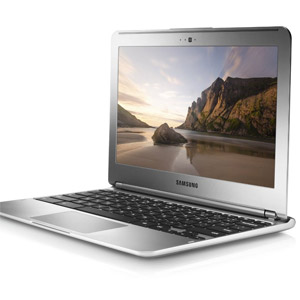 NEWS
NEWS
 NEWS
NEWS
 NEWS
NEWS
![]() Once running, the Chromebook boots with miracle swiftness and whisper silence. First, it wants to know how to connect to the nearest Wi-Fi network. The Chromebook doesn’t run very well (initially) without a connection to the Internet. I expected this, it is after all an OS based almost entirely on the cloud that runs mostly web pages–and that part is most palpable when the next wizard wants to know my Google login.
Once running, the Chromebook boots with miracle swiftness and whisper silence. First, it wants to know how to connect to the nearest Wi-Fi network. The Chromebook doesn’t run very well (initially) without a connection to the Internet. I expected this, it is after all an OS based almost entirely on the cloud that runs mostly web pages–and that part is most palpable when the next wizard wants to know my Google login.
Once I have that filled in, it wants to know what icon I want to use for login (it even helpfully connects to Google and finds my Google avatar; which, of course, I choose to use.)
One thing I notice at this point is how totally quiet this little machine is. From the specs, I’m fairly certain it doesn’t have a fan and it uses flash memory instead of a hard drive. It makes absolutely no sound whatsoever of the mechanical type. I’ve been typing on it for only a few minutes, and I’m only barely getting used to the keyboard but so far it’s not as uncomfortable as I expected from my experience with full size keyboards.
Only a few minutes later
That’s it! The setup consists entirely of telling the Chromebook how to talk to the Internet and giving it my Google login credentials. Done and done. The rest is just diving into the OS.
As part of the setup, the Chromebook helpfully introduces me to the touchpad. Unlike the touchpad of the usual laptop, it has no buttons–although I discover later that the lower tips of the touchpad click like buttons. First, instructions on how to click and double-click. Right clicking is accomplished by tapping with two fingers at once and scrolling is done by swiping with two fingers. Click-and-drag eludes me at first–it involves touching the object to move with one finger and swiping with another; but it’s much easier if I click down on the corner of the touchpad for the click and swipe.
After I finally dismiss the wizard, the desktop is sleek and empty. For me, its a mountain lake vista with a lovely sky and sun flying across the landscape. Soothing actually, I wonder if that’s the default background everyone gets.
Along the bottom of the screen is a set of icons Chrome browser, Gmail, Google search, YouTube, and an icon that leads to the Chrome store. On the other side is the time, an indicator telling me there’s already an update to download for Chrome OS, an indicator to my Wi-Fi strength, battery life, and my Google avatar.
As a writer, the keyboard is an extremely important feature
First thing I do–after closing the “Get to know your Chromebook” window–is to log into my Gmail. There’s an icon right there fore it, after all and Gmail is exactly what I need to use on an almost constant basis to keep up with my peers and editors here at SiliconANGLE. It loads quickly, filled with my most recent correspondence, and a few new items I hadn’t seen since leaving my PC to unbox the Chromebook.
At this point, I think it’s time to put the keyboard through its paces. If you’re reading this, you’ve already read the product of that–it’s the article about unboxing the Chromebook.
The keyboard on the device doesn’t quite feel full sized compared to the keyboards that I normally use. It’s slight, almost intangible against my fingertips, and it doesn’t make much noise when I strike the keys in rapid succession. It’s an island-style laptop keyboard that lacks much of the tactile response of a scissor or spring keyboard–but my fingers have no trouble finding the keys, they have enough texture to make them easy to use.
The learning curve is short. It only took me one article to get used to the slightly different keyboard layout and the difference in tactile response from the keys. One thing that I notice is that the keyboard is highly responsive and Chrome OS is definitely quick-on-its feet.
This device feels a lot like a full powered laptop running so far (although I’ve only used it so far to surf the web and use web office apps.)
Part 1: The Unboxing | Part 2: The Setup | Part 3: The Apps | Part 4: Entertainment
The device used for this review is the 3G version of the Samsung Chromebook (XE303C12-H01US), 11.6” screen, 1.7 GHz Exynos 5200 processor, 2 GB DDR3L SDRAM, and 16 GB Flash hard drive. Over the extent of the review, I updated the Google Chrome OS once and wrote the entirety of the review series using the Chromebook and the available apps on the device itself.
Support our mission to keep content open and free by engaging with theCUBE community. Join theCUBE’s Alumni Trust Network, where technology leaders connect, share intelligence and create opportunities.
Founded by tech visionaries John Furrier and Dave Vellante, SiliconANGLE Media has built a dynamic ecosystem of industry-leading digital media brands that reach 15+ million elite tech professionals. Our new proprietary theCUBE AI Video Cloud is breaking ground in audience interaction, leveraging theCUBEai.com neural network to help technology companies make data-driven decisions and stay at the forefront of industry conversations.